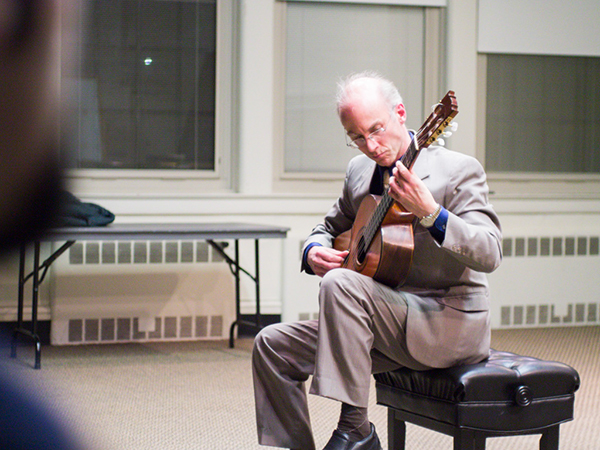
Nadia and Max Shepard Recital Hall hosted a concert entitled “Three Centuries of Music for the Classical Guitar” on Tuesday, Feb. 24 at 8 p.m. It was an entire program dedicated to one classical guitar played by Greg Dinger.
Greg Dinger is a faculty member of the music department at SUNY New Paltz as well as SUNY Ulster and Bard College. Dinger has played the classical guitar since ninth grade and on Tuesday night, he dedicated his entire program to his one classical guitar, with no vocals or electronic effects.
The lights dimmed and Dinger began his performance with music by Sylvius Leopold Weiss.
As stated in the program, Weiss is one of the most important lutenist’s of his period. His music was written without barlines in unmeasured style, which translates how improvisational this music was. His music can rush forward, or slow down, it is solely up to the improviser.
The program included pieces that started in the 18th century that just make it to the mid-20th century, the reason behind the title of the show.
According to Dinger, the first half of the show was more historical with one era leading to the next. The second half of the show was South American music from different composers who have stark differences in their music.
He also added that the show features instruments the guitar often borrows from. For instance, the lute in his first set of pieces by Weiss, the violin from music by Jean-Delphin Alard and mainstream guitar from the early 19th century and from the 20th century.
After intermission, Dinger gave the audience an opportunity to hear music from 20th century South American composers as he interpreted on classical guitar.
He played music from Mexico’s first influential composer, Manuel Ponce, Brazilian guitarist and composer Heitor Villa-Lobos as well as Argentinian player and composer Jorge Morel.
“I chose the pieces to make a three-piece sequence – like a ‘make-your-own’ sonata for each composer, generally following the arc of introductory-slow-conclusive (fast),” Dinger said. “In most cases, the last piece in a group leads to the first piece in the next group.”
Dinger said that choosing a favorite piece to perform is difficult. He says that when he plays some of these pieces, he plays them as though they are the best pieces of music in the world. He pointed in particular to “Praeludium & Capriccio” by Weiss and “Choros” by Morel.
“I know several of the pieces are crowd-pleasers and I enjoy thinking that I’m making my audience happy with those,” Dinger added.
The most exciting aspect of his performance was with just one guitar and four fingers, Dinger played the equivalent of piano music and all from memory.
Dinger was able to present his audience with a new outlook on guitar; one without vocals. A simple acoustic, nylon-string type guitar without electric or bass and with a historical twist.
